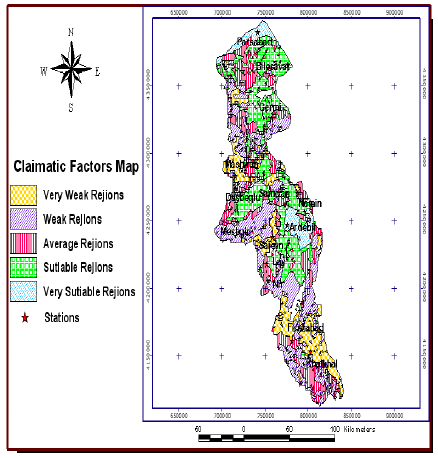Using GIS, Fariba Esfandyary of the University of Mohaghegh Ardabili in Ardabil, Iran did a study and found regions favorable for the cultivation of canola seeds in the Ardabil Province. One of the most important factors affecting the quality and quantity of agricultural crops during the growth and reproductive stages is the regional climate. Using different layers in the GIS model including rainfall throughout the growth period, frost, temperature, and sunshine hours, he found the least and best suitable regions of the area for cultivation of canola.
Using the table of regional needs below, the effects of climatic elements and factors were used the determine regions conductive to canola cultivation in the Ardabil Province. Canola needs a soil depth between 0 and 2.5cm, depending of the type of soil and plant. Temperature also influences the environment and the humidity of the soil, which can help or hurt the canola plant’s production. Canola is a product of cold temperature regions. There are two types of canola plants: autumn and spring. The autumn type requires 6-8 weeks of cold and when these conditions are met, the relative performance is increased.
 | |||
| Table 1. Climatic needs of autumn canola in dry farming |
Because canola requires less water it can be cultivated by two methods: dry farming and water farming. It was found that the amount of water required for the cultivation of canola is between 210 and 550mm, depending on the air temperature and potential evaporation in dry regions. Canola also requires a long day, its flowering is promoted as the length of the day increases. Light is important and increases the growth of the vegetation. Previous studies have proven that 2,000 hours of sunshine is not restricting for canola.
To analyze the climatic elements, climatic-agricultural zonation of the province for canola cultivation was performed using GIS. Various data was collected from the survey department of Jahad Agricultural Organization including: mean daily temperature, mean minimum absolute temperature, precipitation during growth period, mean maximum temperature, frost and sunshine hours from different synoptic stations, climatology, measurement of rainfall and evaporation, and physiographic factors such as topography, slopes, land use, and soil depth.
Climatic factors in combination are very influential in determining the climatic potential for canola cultivation in different regions of Ardabil Province, and it was determined that the overall amount of precipitation in most areas of the province and the distribution of the north west of the province as well as low temperatures and extreme frost in Bostan Abad and Sarab are the main restrictions to the cultivation of canola in Ardabil.
Based on the climatic factors, suitable regions for the cultivation of canola were identified. Although about 35% of the region studied may be conductive to canola cultivation, only about 10% of the region is favorable for canola cultivation without restrictions.
 | ||||||
| Figure 1. Suitable regions to cultivate canola in the Ardabil Province. |

There are a few limitations to this study. For one, the use of GIS to make only climatic factors doesn't take into account what other variables could influence the availability of canola production such as land open for cultivation in comparison to urban areas; income of the inhabitants of each region; and political restrictions for certain areas. This is useful information because we can see what kinds of activities are taking place in very suitable regions (such as urbanization, other crops being grown) that could show that the way farming of canola occurs now is ineffective. Another concern may be that lower income communities live in unsuitable regions, indicating the need to attend to other economic opportunities in these communities in order to ensure protection of livelihoods. Ultimately, the biological factors of climate are great but the study should include political, economical and social variables to show where farming of canola really can take place effectively.
ReplyDelete